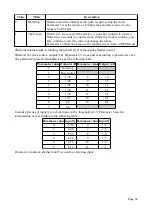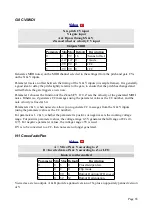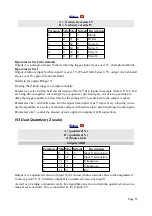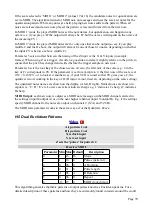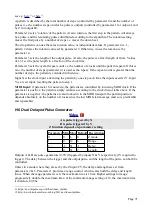
see e.g.
A pattern is described by the total number of steps (controlled by parameter 0) and the number of
pulses (i.e. the number steps on which a pulse is output) (controlled by parameter 1 for output A and
by Z for output B).
Parameter 2 sets a 'rotation' of the pattern. At zero rotation, the first step in the pattern will always
be a pulse, and the remaining pulses distributed according to the algorithm. The rotation setting
moves the first pulse by a number of steps i.e. moves the down beat.
The two patterns can use the same rotation value, or independent values. If parameter 4 is -1,
pattern 2 shares the rotation value set by parameter 2. Otherwise, it uses the rotation set by
parameter 4.
Parameter 3 sets the length of the output pulse. At zero, the pulse is a fixed length of 10ms. Values
of 1-31 set the pulse length to a fraction of the clock time.
Parameter 5 sets the overall repeat count i.e. the number of clocks until the pattern repeats. If this is
zero, the number of steps (parameter 0) is used as the repeat. If the repeat count is greater than the
number of steps, the pattern is extended with silence.
Input X is the clock input, advancing the pattern by one step each time the input exceeds 1V. Input
Y is a reset input, resetting the pattern to step 1.
MIDI Input:
if parameter 6 is non-zero, the patterns are controlled by incoming MIDI clock. If the
parameter is positive, the patterns simply advance according to the clock divisor table above. If the
parameter is negative, the patterns are also locked in to the MIDI transport: the pattern position
depends absolutely on the number of clocks since the last MIDI start message (and so is predictable
and repeatable).
H-6 Dual Delayed Pulse Generator
A is pulse triggered by X
B is pulse triggered by Y
Z function depends on parameter setting
Parameter Min Max Default Description
0
0
6
0
Z mode.
1
0
12
6
Range.
2
-1
31
-1
Delay.
3
0
31
7
Length.
Outputs A & B are pulse generators (0-5V) triggered by inputs X & Y respectively (1V required to
trigger). The delay between the trigger and the output pulse, and the length of the pulse, can both be
controlled.
Unless in a mode where they are set by the Z input/CV, the delay and length are set from
parameters 2 & 3. Parameter 1 provides a range control, which scales both the delay and length
times. When the range parameter is 0, the maximum time is 10ms. Higher settings for range
progressively double the maximum time; at the maximum ranage setting of 12, the maximum time
is therefore 40.96s.
11 https://en.wikipedia.org/wiki/Euclidean_rhythm
12 http://www.hisschemoller.com/blog/2011/euclidean-rhythms/
Page 71






